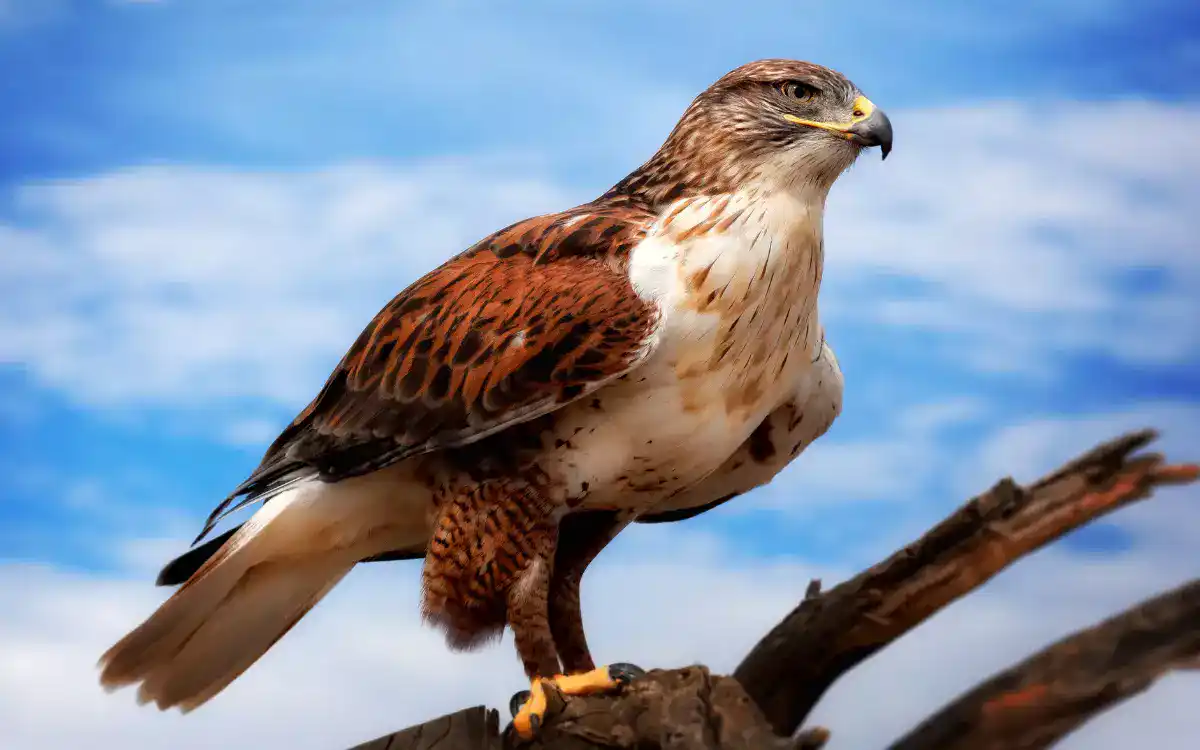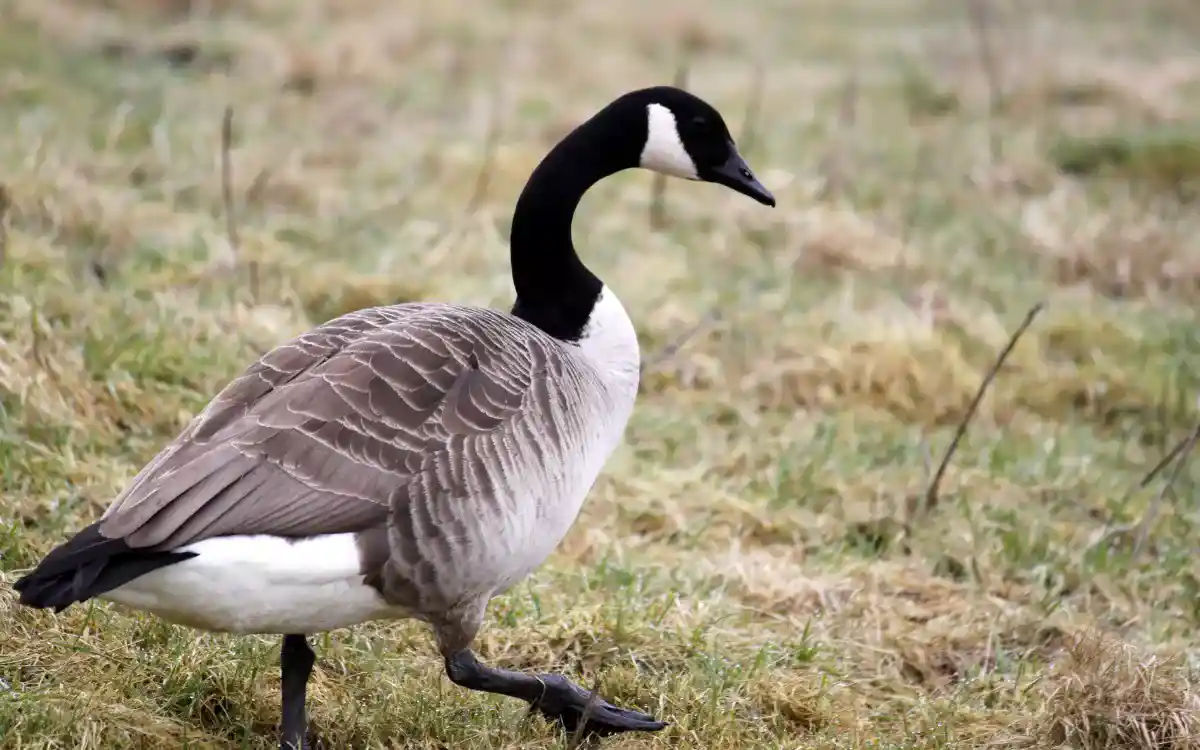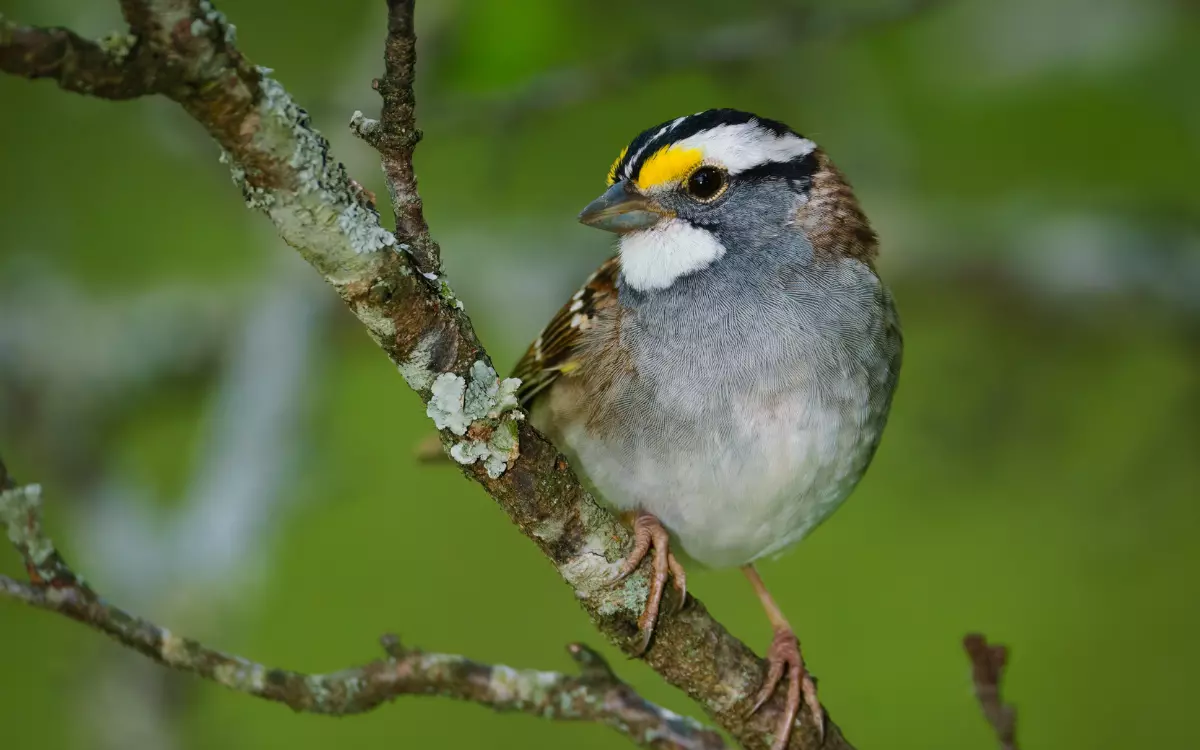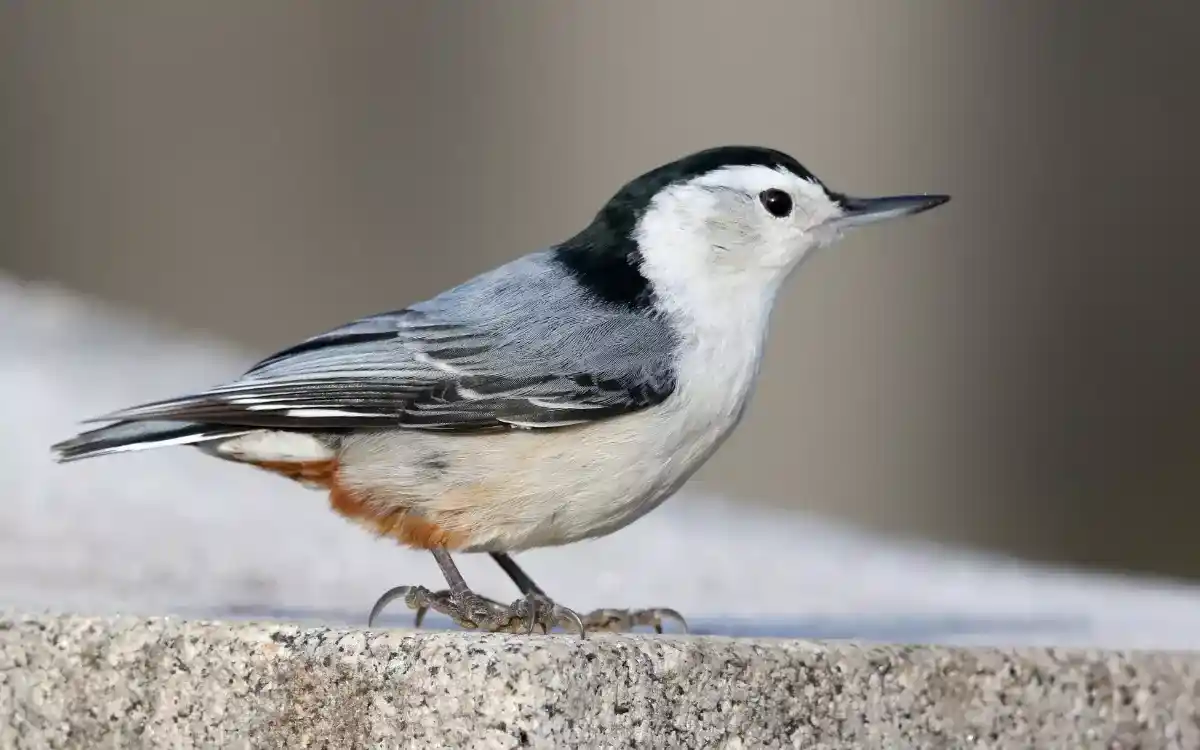9 Blackbirds in Florida: That Attracts You Eyes
Find the beautiful avian tapestry of Florida, where 9 different blackbird species thrive. From the striking Red-winged Blackbird to the elusive Yellow-headed Blackbird, delve into the variety of blackbirds in Florida.
1.Common Grackle (Quiscalus quiscula):
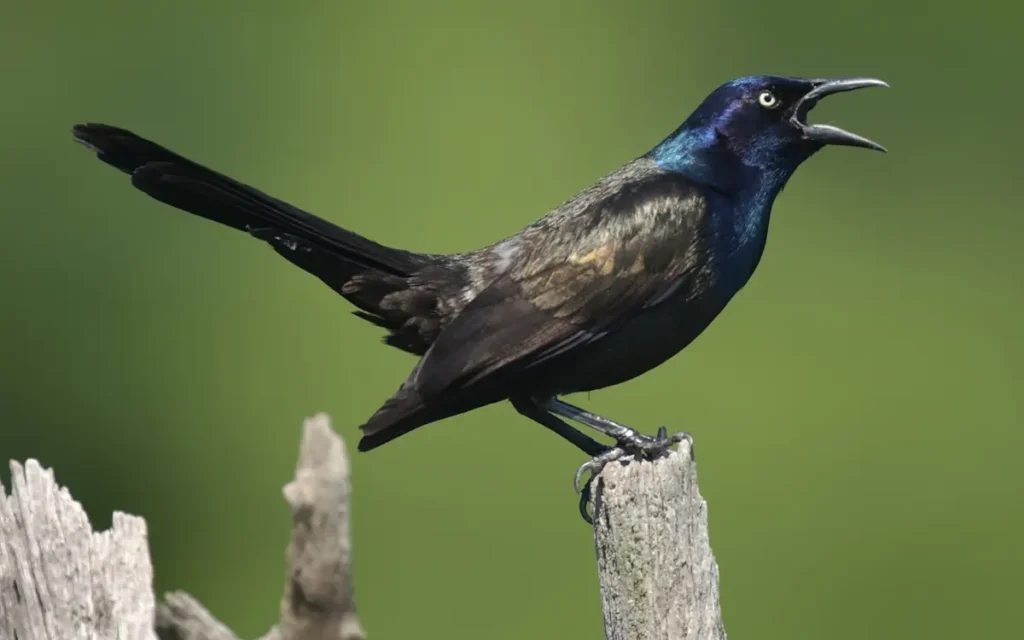
- Kingdom: Animalia
- Phylum: Chordata
- Class: Aves
- Order: Passeriformes
- Family: Icteridae
- Genus: Quiscalus
- Species: Quiscalus quiscula
The Common Grackle is a medium-sized bird with shiny black feathers and bright yellow eyes. In Florida, you can spot them in parks, fields, and wetlands. They’re everywhere!
Behaviorally, Common Grackles love being around others. They often travel and eat together, making joyful noises along the way.
These birds eat bugs, seeds, fruits, and sometimes even tiny animals. Keep your eyes peeled for these sociable creatures—they’re Florida’s friendly neighbors!
- Length: 11.0-13.4 in (28-34 cm)
- Weight: 2.6-5.0 oz (74-142 g)
- Wingspan: 14.2-18.1 in (36-46 cm)
2. Boat-tailed Grackle (Quiscalus major):
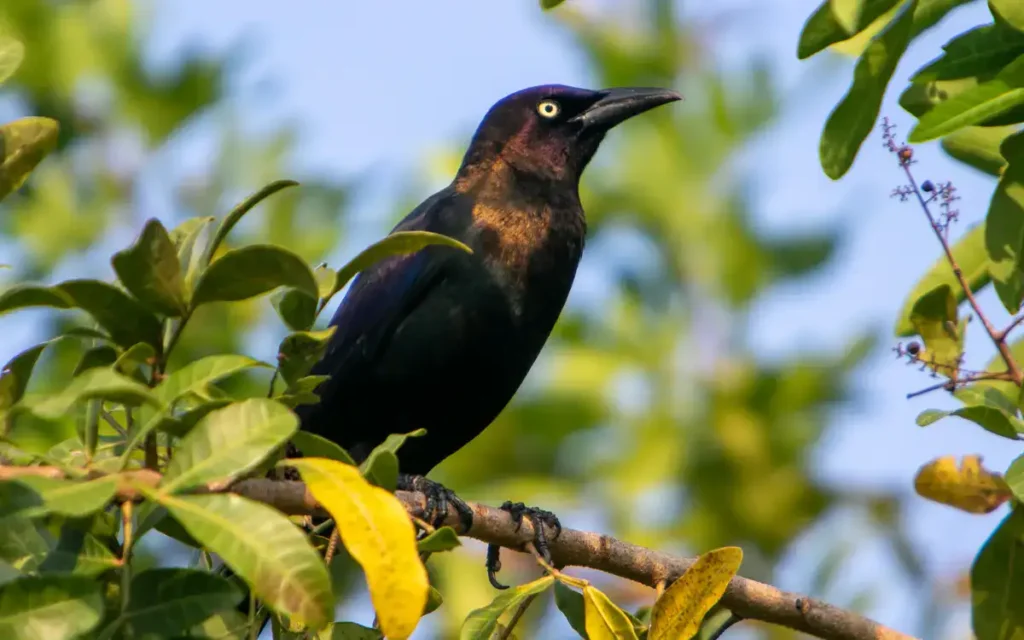
- Kingdom: Animalia
- Phylum: Chordata
- Class: Aves
- Order: Passeriformes
- Family: Icteridae
- Genus: Quiscalus
- Species: Quiscalus major
The Boat-tailed Grackle resembles the Common Grackle but has a longer tail and more iridescent feathers. They’re often found near water bodies like marshes and beaches in Florida.
Ecologically, Boat-tailed Grackles help control insect populations and disperse seeds. They’re crucial for maintaining the balance of their habitat.
Behaviorally, these birds are skilled hunters and often use their long bills to probe for food in mud and water. Their adaptations make them perfectly suited for coastal living.
- Length: 10.2-14.6 in (26-37 cm)
- Weight: 3.3-8.4 oz (93-239 g)
- Wingspan: 15.3-19.7 in (39-50 cm)
3. Red-winged Blackbird (Agelaius phoeniceus):
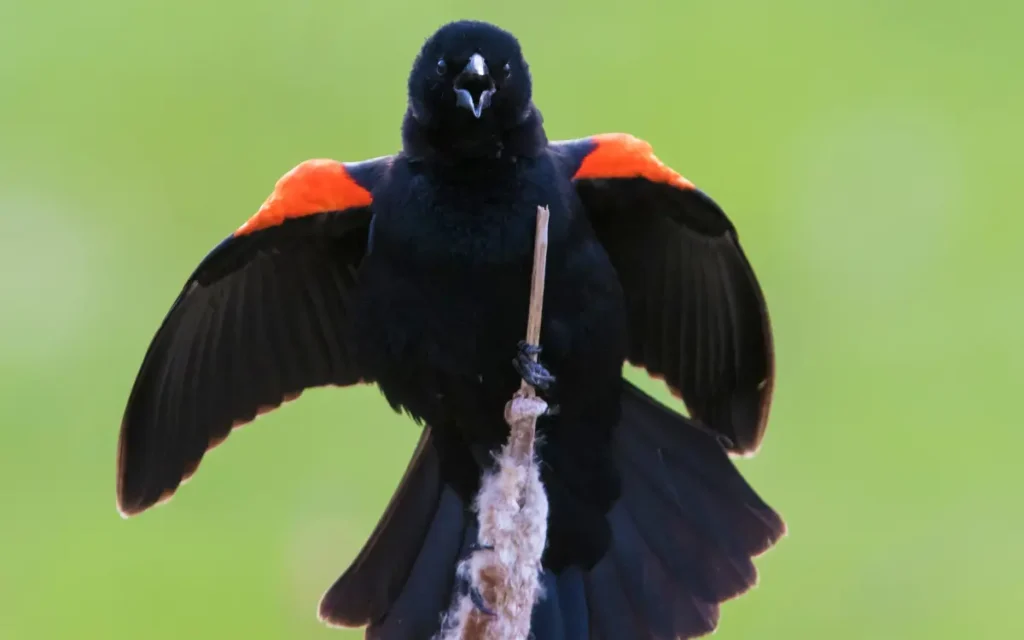
- Kingdom: Animalia
- Phylum: Chordata
- Class: Aves
- Order: Passeriformes
- Family: Icteridae
- Genus: Agelaius
- Species: Agelaius phoeniceus
The Red-winged Blackbird is small with glossy black feathers and bright red patches on its wings. In Florida, they’re commonly found in marshes and wetlands.
Breeding habits involve males puffing up their red patches to attract females. They build cup-shaped nests in tall grasses near water bodies.
Ecologically, Red-winged Blackbirds help control insect populations and disperse seeds, playing a vital role in Florida’s ecosystem.
- Length: 7.1-9.1 in (18-23 cm)
- Weight: 1.5-2.7 oz (42-77 g)
- Wingspan: 12.6-15.8 in(32-40 cm)
4. Bobolink (Dolichonyx oryzivorus):
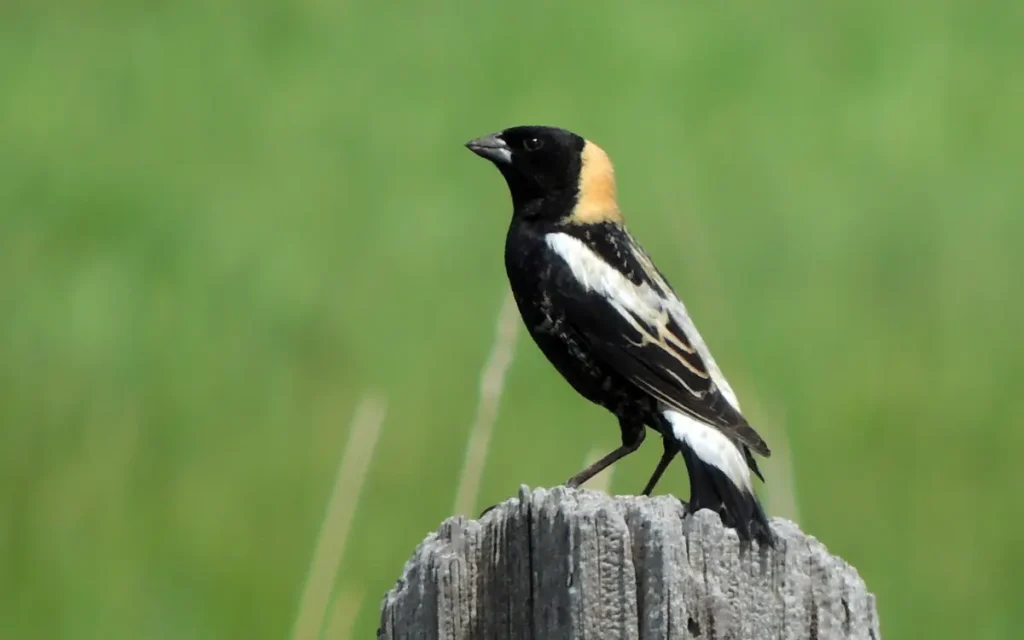
- Kingdom: Animalia
- Phylum: Chordata
- Class: Aves
- Order: Passeriformes
- Family: Icteridae
- Genus: Dolichonyx
- Species: Dolichonyx oryzivorus
The Bobolink is a small bird with black and white feathers, resembling a tiny bumblebee. In Florida, they’re seen during spring and fall migration periods.
Migration patterns take Bobolinks from their breeding grounds in North America to South America for winter.
Conservation-wise, Bobolinks face habitat loss due to agricultural practices. Protecting grasslands and creating safe stopover sites is crucial for their survival.
- Length: 6.3-7.5 in (16-19 cm)
- Weight: 1.2-1.8 oz (34-51 g)
- Wingspan: 9.8-11.8 in (25-30 cm)
Read also:
- 14 White Birds in Florida
- 16 Brown Birds In Florida
- 12 Backyard Bird in Florida: Complete Guide
- 10 Woodpeckers in Florida (Id & Pic)
- 11 Types of Red Birds in Florida
5.Common Gallinule (Gallinula galeata):
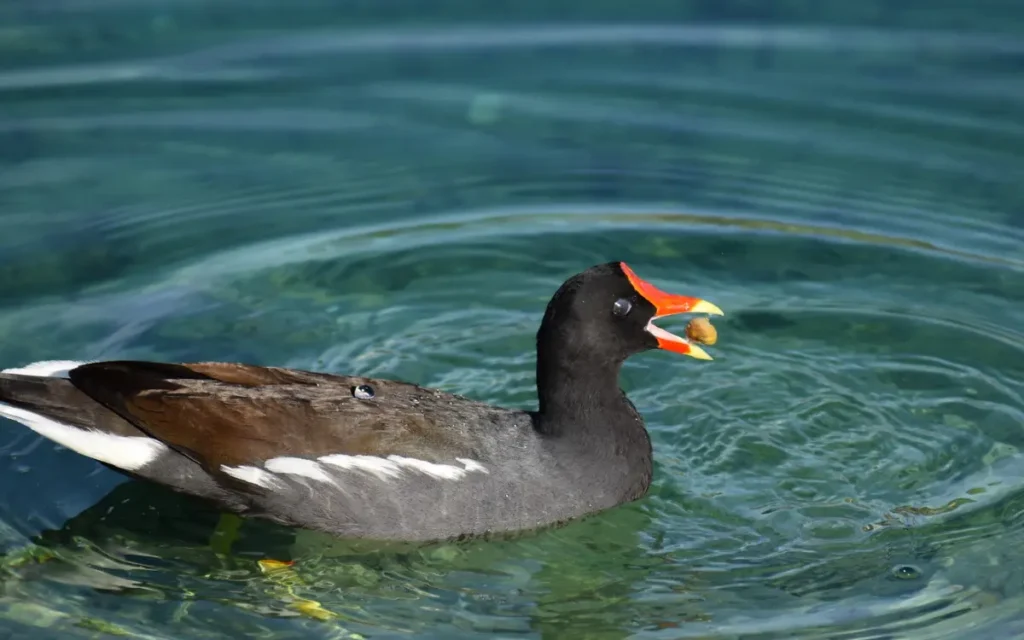
- Kingdom: Animalia
- Phylum: Chordata
- Class: Aves
- Order: Gruiformes
- Family: Rallidae
- Genus: Gallinula
- Species: Gallinula galeata
The Common Gallinule may seem like a duck but is often included in discussions about blackbird species due to its dark plumage and similar habitat preferences.
In wetland habitats, they wade in shallow waters, using their long toes to grab aquatic plants and insects.
Conservation efforts focus on preserving wetlands, as they provide crucial habitat for Common Gallinules and many other species. Protecting these areas ensures their populations thrive.
- Length: 12.6-14.2 in (32-36 cm)
- Weight: 10.6-27.3 oz (300-775 g)
- Wingspan: 23.2-27.6 in (59-70 cm)
6. American Crow (Corvus brachyrhynchos):
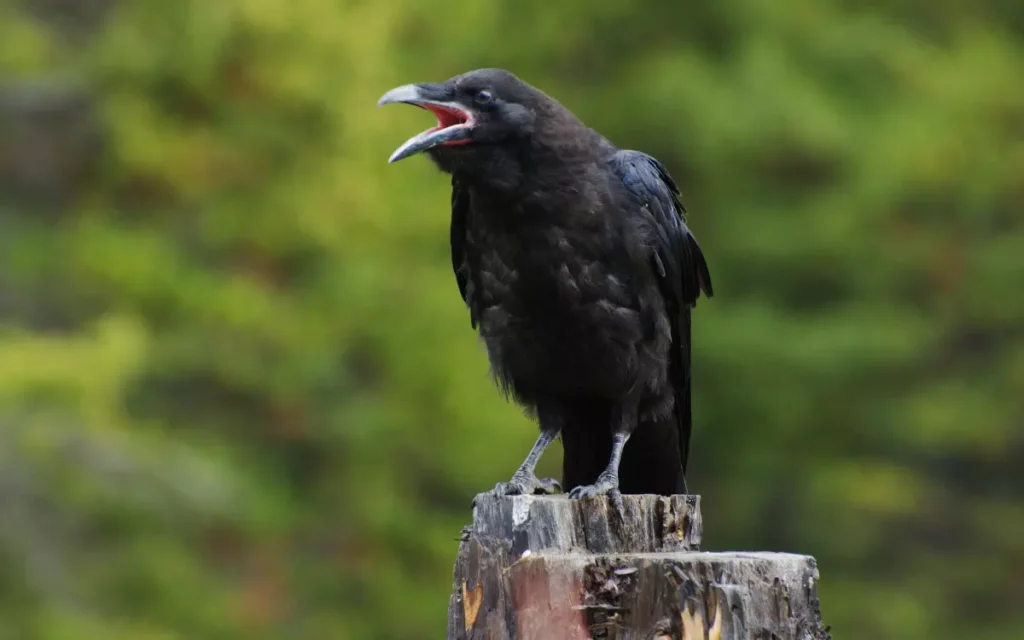
- Kingdom: Animalia
- Phylum: Chordata
- Class: Aves
- Order: Passeriformes
- Family: Corvidae
- Genus: Corvus
- Species: Corvus brachyrhynchos
The American Crow is a common sight in Florida, seen in urban areas, forests, and even beaches.
Adaptability is their superpower—they can thrive in diverse environments, from cities to rural landscapes.
Impacts on local ecosystems include scavenging on carrion and preying on small animals, which can disrupt natural balances. However, they also help by cleaning up waste and controlling pest populations.
- Length: 16.5-21.0 in (42-53 cm)
- Weight: 11.2-21.9 oz (318-621 g)
- Wingspan: 33.1-39.4 in (84-100 cm)
Read also: 11 Types of Red Birds in Florida
7. Cormorant (Phalacrocorax carbo):

- Kingdom: Animalia
- Phylum: Chordata
- Class: Aves
- Order: Suliformes
- Family: Phalacrocoracidae
- Genus: Phalacrocorax
- Species: Phalacrocorax carbo
The Cormorant might not look like a typical blackbird, but it’s classified as one due to its dark plumage and similar ecological role.
Aquatic habitats are where Cormorants thrive, often seen swimming and diving in rivers, lakes, and coastal waters.
Human interactions sometimes lead to conflicts, as Cormorants can compete with fishermen for fish. However, they also help maintain healthy fish populations by controlling smaller fish and maintaining ecosystem balance.
- Length: 28.3-35.4 in (72-90 cm)
- Weight: 2.6-6.6 pounds (1200-3000 g)
- Wingspan: 47.2-59.1 in (120-150 cm)
8. Brewer’s Blackbird (Euphagus cyanocephalus):
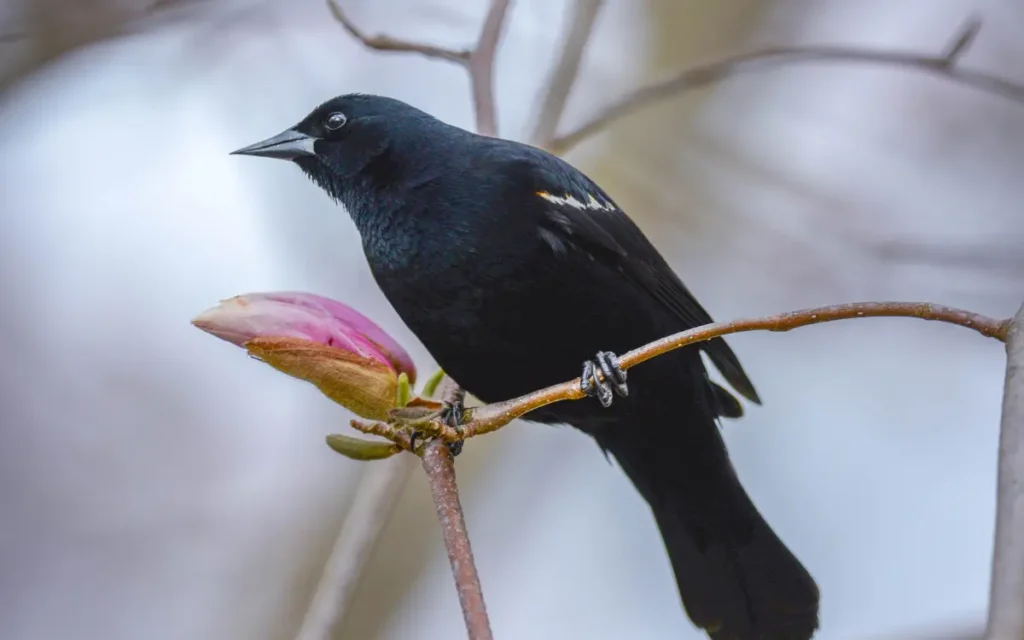
- Kingdom: Animalia
- Phylum: Chordata
- Class: Aves
- Order: Passeriformes
- Family: Icteridae
- Genus: Euphagus
- Species: Euphagus cyanocephalus
Brewer’s Blackbird is a recent arrival in Florida, often spotted in open fields and urban areas.
Foraging behaviors involve searching for insects, seeds, and grains on the ground.
Conservation status is currently stable, but monitoring is needed as their population trends may change with habitat alterations. Encouraging habitat preservation and reducing pesticide use can help ensure their continued presence in Florida’s diverse avian community.
- Length: 8.7-10.2 in (22-26 cm)
- Weight: 2.1-3.5 oz (60-100 g)
- Wingspan: 14.2-16.9 in (36-43 cm)
9. Yellow-headed Blackbird (Xanthocephalus xanthocephalus):
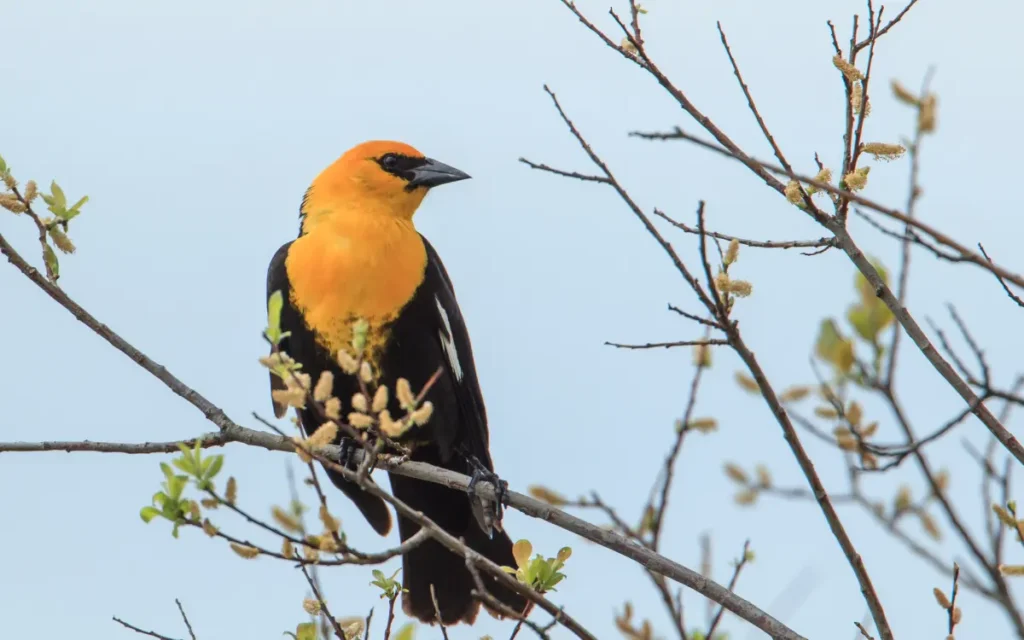
- Kingdom: Animalia
- Phylum: Chordata
- Class: Aves
- Order: Passeriformes
- Family: Icteridae
- Genus: Xanthocephalus
- Species: Xanthocephalus xanthocephalus
The Yellow-headed Blackbird is a rare sight in Florida, spotted mostly in marshes and wetlands during migrations.
These birds prefer wetland areas and travel long distances from the northern U.S. and Canada to the south each year.
It’s very important to protect their habitats to make sure they can visit us safely. Conservation efforts help maintain healthy populations of these unique birds and ensure that they have safe places to stop during their long journeys.
- Length: 8.7-10.6 in (22-27 cm)
- Weight: 3.0-4.9 oz (85-140 g)
- Wingspan: 13.8-17.7 in (35-45 cm)
10.American Coot
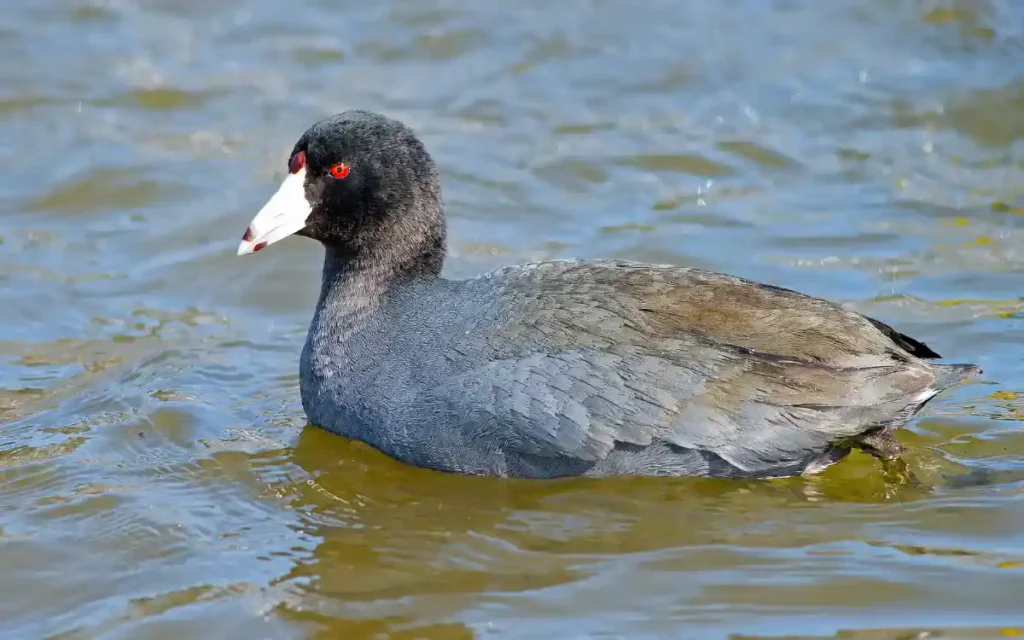
The American Coot is a special bird that’s part of the large black birds family in Florida. different from ducks, it has a sleek black body, a white beak, and greenish legs.
Coots love wetlands – places like lakes and marshes are their favorite spots. In Florida, these birds are mostly winter visitors.
They come here to enjoy the warmer weather when it’s cold elsewhere. During this time, you’ll see them swimming around, diving for plants to eat, and sometimes walking awkwardly on land.
Coots are social and noisy, often found in big groups, making them interesting birds to watch.
- Scientific Name – Fulica
- Length: 15.5 – 16.9 in (39.4 – 42.9 cm),
- Weight: 21.2 – 24.7 oz (600 – 700 gm)
- Wingspan:23.0 – 25.0 in (58.4 – 63.5 cm)
11.Common Grackle

The Common Grackle is a big, shiny bird. It looks black, but when the sun hits, it shines blue or purple. It has a long tail and a strong bill. Grackles love to hang out together, making a lot of noise and having fun.
They’re good for our world because they eat lots of insects and seeds, keeping nature in balance. You can find them in many places like parks, fields, and near water in Florida.
- Scientific name –Quiscalus quiscula
- Length: 11.0 – 13.4 in (28 – 34 cm)
- Weight: 2.6 – 5.0 oz (74 – 142 gm)
- Wingspan:14.2 – 18.1 in (36 – 46 cm)
12.Great-tailed Grackle:
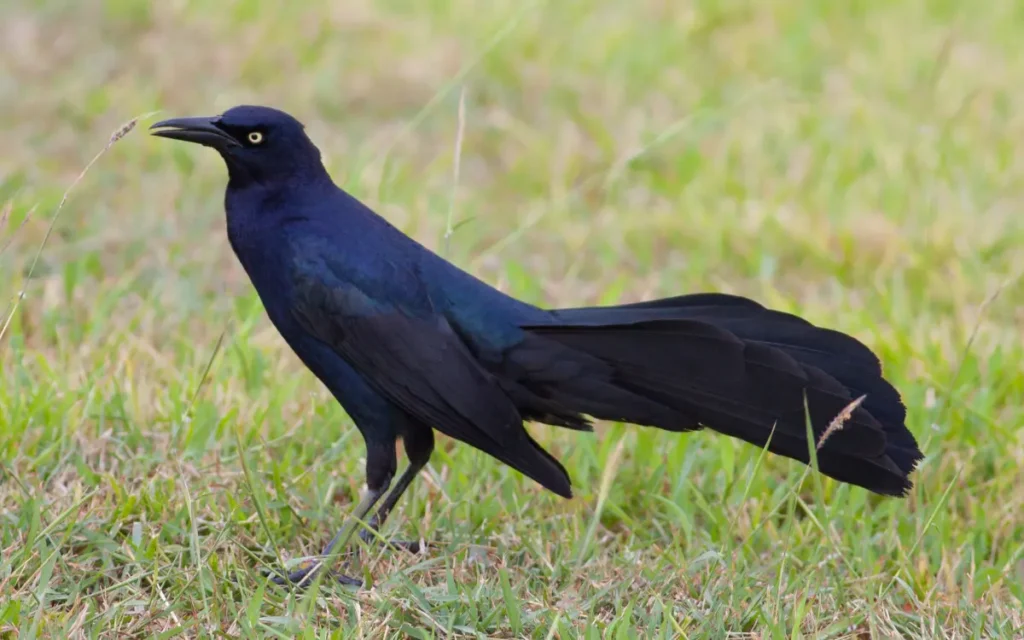
The Great-tailed Grackle stands out from the Common Grackle with its longer tail and more dramatic colors. It has spread far, now found in many places where it wasn’t seen before.
These birds love to make their homes near water and in open areas. They are smart about where they build nests, often choosing places that are hard for predators to reach.
Great-tailed Grackles are known for their loud and varied songs. They can make a lot of different sounds, from whistles to chatters, which makes them fun to listen to.
- Scientific name –Quiscalus mexicanus
- Length: 15.0 – 18.1 in (38 – 46 cm)
- Weight: 3.7 – 6.7 oz (105 – 190 gm)
- Wingspan: 18.9 – 22.8 in (48 – 58 cm)
13.Turkey Vulture
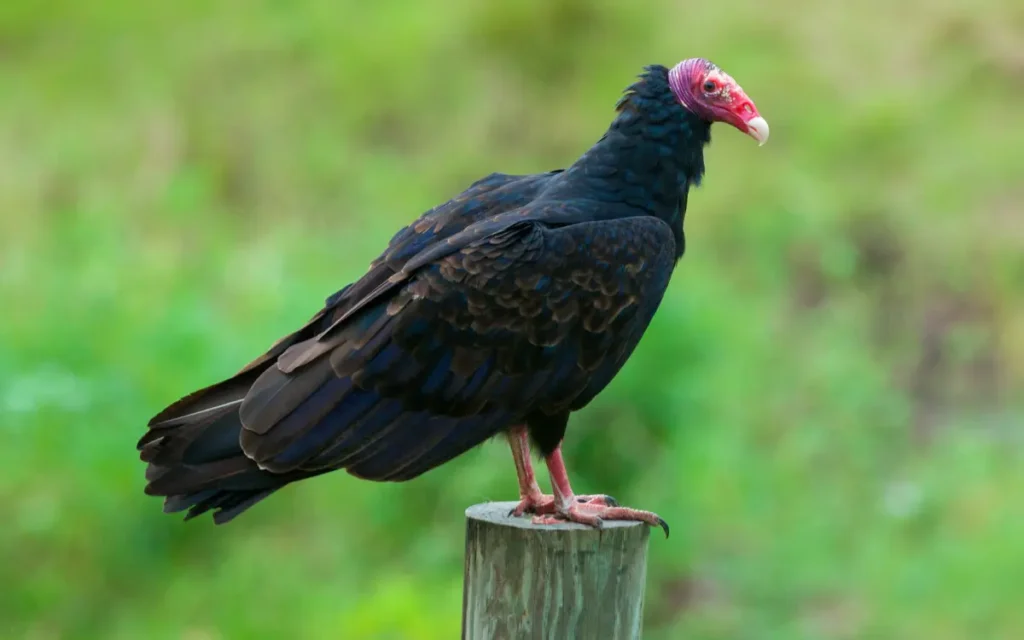
The Turkey Vulture is a big, black bird with a red head. It might not be the prettiest, but it’s very important. These birds are scavengers, which means they eat dead animals. This helps keep the environment clean and stops the spread of diseases.
To spot a Turkey Vulture, look for a bird flying in the sky with its wings in a ‘V’ shape. They are great at soaring without flapping much.
These vultures travel south in winter and come back in spring, making them part-time residents in some places.By eating what others leave behind, Turkey Vultures play a key role in nature, making them heroes of the ecosystem.
- Scientific name –Cathartes aura
- Length: 25.2 – 31.9 in (64 – 81 cm)
- Weight: 70.5 oz (2000 gm)
- Wingspan: 66.9 – 70.1 in (170 – 178 cm)
14.Boat-tailed Grackle

The Boat-tailed Grackle is a special bird that looks a bit like the Common Grackle, but it’s different. It has a longer tail that looks like a boat, and it loves living near water—places like marshes and coastal areas.
These birds are great at making nests. They build them in places that are safe from harm, often in tall reeds or bushes. When it comes to babies, both mom and dad help take care of them.
For food, they eat almost anything. From insects to seeds and even small animals, they’re not picky eaters. Living by the water and having a varied diet makes the Boat-tailed Grackle a interesting bird to learn about.
- Scientific name –Quiscalus major
- Length: 10.2 – 14.6 in (26 – 37 cm)
- Weight: 3.3 – 8.4 oz (93 – 239 gm)
- Wingspan: 15.3 – 19.7 in (39 – 50 cm)
FAQs:
Q: Are ravens or crows in Florida?
Ans: Crows are common in Florida, but ravens are generally not found in the state.
Q: What is Florida’s most common bird?
Ans: The Northern Mockingbird is one of the most common and is also the state bird of Florida.
Q: Is a blackbird a crow or a raven?
Ans: No, blackbirds are not crows or ravens. They belong to different families, though all are part of the larger order of passerine birds.
Q: What is Florida’s national bird?
Ans: Florida does not have a “national” bird, but the Northern Mockingbird is the official state bird.
Q: What bird is only found in Florida?
Ans: The Florida Scrub-Jay is unique to Florida and is not naturally found anywhere else.
Q: Does Florida have parrots?
Ans: Yes, Florida has several species of parrots, mostly as a result of pet releases and escapes. Notable among them are the Monk Parakeet and the Red-crowned Parrot.
Conclusion:
Florida is home to nine fascinating blackbird species. It’s important to learn about and protect these birds to keep Florida’s ecosystems healthy and full of life for years to come.

